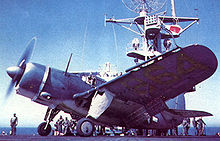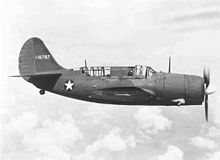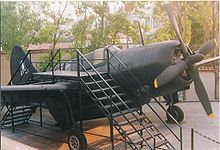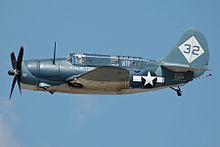- Curtiss SB2C Helldiver
-
"SBF-1" redirects here. For the earlier XSBF-1, see Grumman XSBF. For the biplane Helldiver, see Curtiss SBC Helldiver.
SB2C Helldiver
A-25 ShrikeCurtiss SB2C Helldiver in tricolor scheme and tail markings for Bombing Squadron 80 (VB80) operating off USS Hancock, Feb 1945. Role Dive bomber National origin United States Manufacturer Curtiss-Wright
Fairchild (Canada) (SBF)
Canadian Car & Foundry (SBW)First flight 18 December 1940 Introduction December 1942 Retired 1959 (Italian Air Force) Primary users United States Navy
United States Army Air Forces
French Air Force
Royal Thai Air ForceProduced 1943–1945 Number built 7,140 Developed into XSB3C The Curtiss SB2C Helldiver was a carrier-based dive bomber aircraft produced for the United States Navy during World War II. It replaced the Douglas SBD Dauntless in US Navy service. Despite its size, the SB2C was much faster than the SBD it replaced. Crew nicknames for the aircraft included the Big-Tailed Beast (or just the derogatory Beast),[1] Two-Cee and Son-of-a-Bitch 2nd Class (after its designation and partly because of its reputation for having difficult handling characteristics).[2] Neither pilots nor aircraft carrier skippers seemed to like it.[3]
Although production problems persisted throughout its combat service, it was reported that some pilots soon changed their minds about the potency of the Helldiver.[4]
Delays marred its production. Built for the USAAF as the A-25 Shrike, by the time it was delivered it was no longer required. Substantial orders by the British Royal Navy and the Royal Australian Air Force were both cancelled due to the poor handling of the aircraft. The Truman Committee investigated Helldiver production and turned in a scathing report, which eventually led to the beginning of the end for Curtiss. However, in spite of its problems, the aircraft was flown through the last two years of the Pacific War with a fine combat record, due to the high training of its crews.[3]
Contents
Design and development
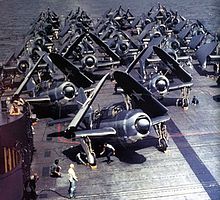 SB2C-1s in tricolor scheme (front) on the flight deck of USS Yorktown in 1943.
SB2C-1s in tricolor scheme (front) on the flight deck of USS Yorktown in 1943.
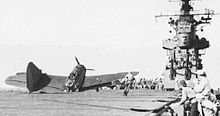 VB-17 SB2C-1 which lost its tail while landing on USS Bunker Hill in 1943.
VB-17 SB2C-1 which lost its tail while landing on USS Bunker Hill in 1943.
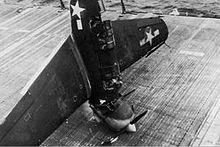 An SB2C Helldiver failed to catch the wire on landing and hit the first barrier, nose-diving into the deck (USS Hornet (CV-12), 3 July 1944).
An SB2C Helldiver failed to catch the wire on landing and hit the first barrier, nose-diving into the deck (USS Hornet (CV-12), 3 July 1944).
The Helldiver was developed to replace the Douglas SBD Dauntless; it was a much larger aircraft able to operate from the latest aircraft carriers of the time and carry a considerable array of armament and featured an internal bomb bay that reduced drag when carrying heavy ordnance. Saddled with demanding requirements set forth by both the U.S. Marines and United States Army Air Forces, the manufacturer incorporated features of a "multi-role" aircraft into the design.[5]
The Model XSB2C-1 prototype initially suffered teething problems connected to its R-2600 engine and 3-bladed propeller; further concerns included structural weaknesses, poor handling, directional instability and bad stall characteristics.[6][7] In 1939, a student brought a model of the new Curtiss XSB2C-1 to the MIT wind tunnel. Professor Emeritus of Aeronautical Engineering Otto C. Koppen was quoted as saying, "if they build more than one of these, they are crazy". He was referencing controllability issues with the small vertical tail.[8]
The first prototype made its maiden flight on 18 December 1940.[9] It crashed on 8 February 1941 when its engine failed on approach, but Curtiss was asked to rebuild it. The fuselage was lengthened and a larger tail was fitted, while an autopilot was fitted as a result of the aircraft's poor stability. The revised prototype flew again on 20 October 1941, but was destroyed when its wing failed during diving tests on 21 December 1941.[10][11]
Large-scale production had already been ordered on 29 November 1940, but a large number of modifications were specified for the production model. The size of the fin and rudder was enlarged, fuel capacity was increased, self-sealing fuel tanks added and the fixed armament was doubled to four 0.50 in (12.7 mm) machine guns in the wings, compared with the prototype's two cowling guns. The SB2C-2 was built with larger fuel tanks, improving its range considerably.
The program suffered so many delays that the Grumman TBF Avenger entered service before the Helldiver, even though the Avenger had begun its development two years later. Nevertheless, production tempo accelerated with production at Columbus, Ohio and two Canadian factories: Fairchild Aircraft Ltd. (Canada) which produced a total of 300 (under the designations XSBF-l, SBF-l, SBF-3 and SBF-4E) and Canadian Car and Foundry which built 894 (designated SBW-l, SBW-3, SBW-4, SBW-4E and SBW-5), these models being respectively equivalent to their Curtiss-built counterparts. A total of 7,140 SB2Cs were produced in World War II.[12]
Operational history
The U.S. Navy would not accept the SB2C until 880 modifications[7] to the design and the changes on the production line had been made, delaying the Curtiss Helldiver's combat debut until November 11, 1943 with squadron VB-17 on the USS Bunker Hill, when they attacked the Japanese-held port of Rabaul on the island of New Britain, north of Papua New Guinea.[7] The first version of the SB2C-1 was kept stateside for training, its various development problems leading to only 200 being built. The first deployment model being the SB2C-1C.[13] The SB2C-1 could deploy slats mechanically linked with undercarriage actuation extended from the outer third of the wing leading edge to aid lateral control at low speeds. The early prognosis of the "Beast" was unfavourable as it was strongly disliked by aircrews due to its size, weight, and reduced range than the SBD it replaced.[14]
In the first Battle of the Philippine Sea, 45 Helldivers were lost because they ran out of fuel on the return to their carriers.[15]
The litany of faults that the Helldiver bore included the fact that it was underpowered, had a shorter range than the SBD, was equipped with an unreliable electrical system and was often poorly manufactured. The Curtiss-Electric propeller and the complex hydraulic system had frequent maintenance problems.[16] One of the faults remaining with the aircraft through its operational life was poor longitudinal stability, resulting from a fuselage that was too short by necessity of the SB2C to fit on aircraft carrier elevators.[7] The Helldiver's aileron response was also poor and handling suffered greatly under 90 knots airspeed; since the speed of approach to land on a carrier was supposed to be 85 knots, this proved problematic.[7] The 880 changes demanded by the Navy and modification of the aircraft to its combat role resulted in a 42% weight increase, explaining much of the problem.[17]
The problems began to be solved with the introduction of the SB2C-3 beginning in 1944, which used the R-2600-20 Twin Cyclone engine with 1,900 HP and Curtiss' 4-bladed propeller. This substantially solved the chronic lack of power that had plagued the aircraft.[13] The Helldivers would participate in battles over the Marianas, Philippines (partly responsible for sinking the Musashi), Taiwan, Iwo Jima, and Okinawa (in the sinking of the Yamato). They were also used in the 1945 attacks on the Ryuku Islands and the Japanese home island of Honshū in tactical attacks on airfields, communications, and shipping. They were also used extensively in patrols during the period between the dropping of the atomic bombs and the official Japanese surrender, and in the immediate pre-occupation period.
An oddity of the SB2Cs with 1942 to 1943-style tricolor camouflage was that the undersides of the outer wing panels carried dark topside camouflage because the undersurfaces were visible from above when the wings were folded.
In operational experience it was found that the U.S. Navy's F6F Hellcat and F4U Corsair fighters were able to carry an equally heavy bomb load against ground targets and were vastly more capable of defending themselves against enemy fighters.[18] The Helldiver, however, could still deliver ordnance with more precision against specific targets and its two seat configuration permitted a second set of eyes.
It was the advent of air to ground rockets which allowed the precision attack of ocean surface and shore based targets without the stress and performance issues of near-vertical dives that dive bombers had to endure[7] that ensured the SB2C was the last purpose-built dive bomber produced.[18]
Postwar, the SB2C remained in active service in the US Navy until 1947 and naval reserve units until 1950. Surplus aircraft were sold to the naval air forces of France, Italy, Greece, Portugal, and Thailand. Greek SB2Cs served in combat in the Greek Civil War with additional machine guns mounted in wing pods. French SB2Cs flew in the First Indochina War from 1951–1954.
Army service
Built at Curtiss' St. Louis plant, 900 aircraft were ordered by the USAAF under the designation A-25A Shrike.[19] The first 10 aircraft had folding wings, while the remainder of the production order omitted this unnecessary feature. Many other changes distinguished the A-25A, including larger main wheels, a pneumatic tail wheel, ring and bead gunsight, longer exhaust stubs, and other Army specified radio equipment. By late 1943 when the A-25A was being introduced, the USAAF no longer had a role for the dive bomber. After offering the Shrike to Australia, only 10 were accepted before the Royal Australian Air Force rejected the remainder of the order, forcing the USAAF to send 410 to the U.S. Marines. The A-25As were converted to the SB2C-1 standard but the Marine SB2C-1 variant never saw combat, being used primarily as trainers. The remaining A-25As were similarly employed as trainers and target tugs.[19]
British service
A comparable scenario accompanied the Helldiver's service with the British. A total of 26 aircraft, out of 450 ordered, were delivered to the Royal Navy's Fleet Air Arm, where they were known as the Helldiver I. After unsatisfactory tests that pinpointed "appalling handling", none of the British Helldivers were used in action.[20]
Greek Service
American Aid provided the Greek Air force with ground attack and some AT-6 aircraft from surplus US Navy stocks with 336 Sqn. Greek Air Force equipped with at least 37 Curtiss SB2C-5 Helldivers from mid 1949 until 1953, before they were replaced with F-84Gs. The Helldivers joined Greek Spitfires and thwarted the attacks of long Communist columns encircling villages, blowing transports, attacking their camps in the mountains with napalm and stopping Albanian, Yugoslavian and Bulgarian troops penetrating into Greece.
Greek SB2C-5s had minor changes for their COIN operations:
- Hard rubber tail wheel (for carrier use) was replaced by a bigger pneumatic tire for use on landing strips.
- Rear gunner station and its twin MGs were deleted, as no aerial opposition existed and extra weight was used for bombs and extra machine guns.
Curtiss SB2C-5 Helldivers saw a relatively brief combat service. Nevertheless, they proved their worth by delivering precise and highly destructive attacks, especially when the Communist guerrilla attempted to fight the Greek National Army in open ground.[citation needed]
French Service
Between 1949 and 1954 France bought 110 SB2C-5 Helldiver aircraft to replace their ageing SBD-5 Dauntless that had been flying in combat in Vietnam. The French Aeronavale flew the Helldiver from 1951 to 1958.
Some of these planes were allotted to Escuadrille 3F stationed onboard the carrier Arromanches, off Vietnam. The Helldivers soon became well thought of by the French troops on the ground during the battle at Dien Bien Phu in 1954. Sometimes only feet above the ground the pilots flew countless sorties strafing and bombing the Viet-Minh troops with a total disregard to the heavy flak. These would be the last combat missions for the Helldiver but probably the most effective missions in the aircraft’s history.
Variants
- XSB2C-1
- Prototype powered by a 1,700 hp (1,268 kW) R-2600-8 engine
- SB2C-1
- Production version for United States Navy with four 0.50 in (12.7 mm) wing guns and one 0.30 in (7.62 mm) dorsal gun, 200 built.
- SB2C-1A
- Original designation for United States Army Air Corps version which became A-25A later used for 410 A-25As transferred to the United States Marine Corps.
- SB2C-1C
- SB2C-1 with two 20 mm (0.79 in) wing-mounted cannons and hydraulically operated flaps, 778 built.
- XSB2C-2
- One SB2C-1 fitted with twin floats in 1942.
- SB2C-2
- Production float plane version, 287 cancelled and not built.
- XSB2C-3
- One SB2C-1 re-engined with a 1,900 hp (1,417 kW) R-2600-20.
- SB2C-3
- As SB2C-1 re-engined with a 1,900 hp (1,417 kW) R-2600-20 and four-bladed propeller, 1,112 built.
- S2BC-3E
- SB2C-3s fitted with APS-4 radar.
- SB2C-4
- SB2C-1 but fitted with wing racks for eight 5 in (127 mm) rockets or 1,000 lb (454 kg) bombs, 2,045 built.
- SB2C-4E
- SB2C-4s fitted with APS-4 radar.
- XSB2C-5
- Two SB2C-4s converted as prototypes for -5 variant.
- SB2C-5
- SB2C-4 with increased fuel capacity, frameless sliding canopy, tailhook fixed in extended position, and deletion of the ASB radar, 970 built (2,500 cancelled).
- XSB2C-6
- Two SB2C-1Cs fitted with 2,100 hp (1,566 kW) R-2600-22 engine and increased fuel capacity.
- SBF-1
- Canadian built version of the SB2C-1, 50 built by Fairchild-Canada
- SBF-3
- Canadian built version of the SB2C-3, 150 built by Fairchild-Canada.
- SBF-4E
- Canadian built version of the SB2C-4E, 100 built by Fairchild-Canada.
- SBW-1
- Canadian built version of the SB2C-1, 38 built by Canadian Car & Foundry company.
- SBW-1B
- Canadian built version for lend-lease to the Royal Navy as the Helldiver I, 28 aircraft built by Canadian Car & Foundry company.
- SBW-3
- Canadian built version of the SB2C-3, 413 built by Canadian Car & Foundry company.
- SBW-4E
- Canadian built version of the SB2C-4E, 270 built by Canadian Car & Foundry company.
- SBW-5
- Canadian-built version of the SB2C-5, 85 built (165 cancelled) by the Canadian Car & Foundry company.
- A-25A Shrike
- United States Army Air Corps version without arrester gear or folding wings and equipment changed, 900 built
- Helldiver I
- Royal Navy designation for 28 Canadian-built SBW-1Bs
Operators
- Royal Hellenic Air Force
- Portuguese Navy (until 1952)
- Portuguese Air Force (after 1952)
Survivors
Airworthy
- United States
- SB2C-5, BuNo. 83589 is airworthy and owned by the Commemorative Air Force (Cactus Squadron) in Graham, Texas. This late-production Helldiver, built in 1945, makes frequent air show appearances. In 1982, it experienced engine failure and a hard emergency landing that caused extensive damage; volunteers of the CAF put in thousands of hours and spent in excess of $200,000 to restore the aircraft to flying condition once more.[21][22]
On display
- France
- Greece
- SB2C-5, BuNo. 83321 is on display at the Hellenic Air Force Museum, Decelea Air Base.[24][25]
- Thailand
- SB2C-5, BuNo. 83410 is on display at the Royal Thai Air Force Museum, Don Muang Royal Thai Air Force Base, Bangkok.[26][27][28]
- United States
- SB2C-5, BuNo. 83479 is on display at the National Museum of Naval Aviation in Pensacola, Florida. It has been on loan from the National Air and Space Museum since 1976.[29][30]
Under restoration
- United States
- A-25A Shrike (s/n 42-80449) is under restoration at the National Museum of the United States Air Force in Dayton, Ohio.[31]
- A-25A Shrike/SB2C-1A, BuNo. 75552 is under restoration by Mike Rawson of Minneapolis, Minnesota for a static display project at the Wings of the North Air Museum in Anoka County, Minnesota.[32]
- A-25A Shrike/SB2C-1A, BuNo. 76805 is under restoration by Mike Rawson of Minneapolis, Minnesota for a static display project at the Wings of the North Air Museum in Anoka County, Minnesota.[33]
- SB2C-3, BuNo. 19075 is under restoration at the Yanks Air Museum in Chino, California [34][35]
- SB2C-4, BuNo. 19866 crashed on 28 May 1945 in Lower Otay Reservoir, near San Diego, California after engine failure during a training exercise. Both pilot E.D. Frazer and his passenger escaped uninjured, but the Helldiver sank in 90 ft. of water.[36] The aircraft was discovered in February 2010 by a fisherman,[37] and recovered on 20 August 2010 for restoration by the National Museum of Naval Aviation in Pensacola, Florida.[38][39]
Recovered
- United States
- In January 2010, Brad Varney, owner of B&B Scuba, discovered a SB2C-1C Helldiver that was ditched in Maalaea Bay off South Maui in August 1944.[40] The Helldiver is covered in coral and is missing its tail section. The aircraft experienced problems with its empennage after dive bombing maneuvers which forced pilot Lieutenant William Dill to ditch.[41] It lies in 50 ft of water facing east. The site, which is protected under state and federal law, is in the process of being marked with a plaque by the US Navy. A mooring may be installed at a later point in time to facilitate dives on the site.[42]
- On 25 March 2010, the Oregon State Police, Tillamook County Sheriff's Office and the United States Navy announced that during a logging operation near Rockaway Beach, Oregon, the wreck of an SB2C Helldiver was located. Initial responders believe there are possible human remains at the scene.[43][44]
Specifications (SB2C-4 Helldiver)
Data from United States Navy Aircraft since 1911[45]
General characteristics
- Crew: Two, pilot and radio operator/gunner
- Length: 36 ft 8 in (11.18 m)
- Wingspan: 49 ft 9 in (15.17 m)
- Height: 13 ft 2 in (4.01 m)
- Wing area: 422 ft² (39.2 m²)
- Empty weight: 10,547 lb (4,794 kg)
- Max takeoff weight: 16,616 lb (7,553 kg)
- Powerplant: 1 × Wright R-2600-20 Twin Cyclone radial engine, 1,900 hp (1,417 kW)
Performance
- Maximum speed: 295 mph (257 knots, 475 km/h) at 16,700 ft (5,090 m)
- Cruise speed: 158 mph (137 knots, 254 km/h)
- Range: 1,165 mi (1,013 nmi, 1,876 km) with 1,000 lb (450 kg) bombload
- Service ceiling: 29,100 ft (8,870 m)
- Rate of climb: 1,800 ft/min (9.1 m/s)
Armament
- Guns:
- 2 × 20 mm (.79 in) cannon in the wings
- 2 × 0.30 in (7.62 mm) M1919 Browning machine guns in the rear cockpit
- Bombs: in internal bay: 2,000 lb (900 kg) of bombs or 1 × Mark 13-2 torpedo[46]
on underwing hardpoints: 500 lb (225 kg) of bombs each
See also
- Related development
- Aircraft of comparable role, configuration and era
- Aichi D3A
- Brewster SB2A Buccaneer
- Douglas SBD Dauntless
- Fairey Barracuda
- Junkers Ju 87 Stuka
- Vultee A-31 Vengeance
- Related lists
- List of military aircraft of the United States (naval)
- List of military aircraft of the United States
References
- Notes
- ^ O'Rourke, G.G, CAPT USN. "Of Hosenoses, Stoofs, and Lefthanded Spads." United States Naval Institute Proceedings, July 1968.
- ^ Shettle 2001, p. 29.
- ^ a b Ethell 1995, p. 221.
- ^ Forsyth 1991, Foreword
- ^ Winchester 2004, p. 63.
- ^ "SB2C Helldiver Curtiss dive bomber: "Helldiver!" What a great name!" acepilots.com. Retrieved: 18 March 2010.
- ^ a b c d e f Guttman, Robert. "Curtiss SB2C Helldiver: The Last Dive Bomber," p. 3. Aviation History via historynet.com , July 2000. Retrieved: 18 March 2010.
- ^ Abzug and Larrabee 1997, p. 92.
- ^ Bowers 1979, p. 424.
- ^ Donald 1995, pp. 76–77.
- ^ Bowers 1979, pp. 424–425.
- ^ Taylor 1969, p. 480.
- ^ a b Goebel, Greg. "The Douglas SBD Dauntless & Curtiss SB2C Helldiver." Vector site, 1 November 2010.
- ^ Winchester 2004, p. 62.
- ^ "Curtiss SBW-1B Helldiver (Curtiss SB2C Helldiver)." Fleetairarmarchive.net, 3 April 2000. Retrieved: 18 March 2010.
- ^ Tillman 1997, p. 61.
- ^ Guttman, Robert. "Curtiss SB2C Helldiver: The Last Dive Bomber", p. 4. Aviation History via historynet.com, July 2000. Retrieved: 18 March 2011.
- ^ a b Guttman, Robert. "Curtiss SB2C Helldiver: The Last Dive Bomber", p. 6. Aviation History via historynet.com, July 2000. Retrieved: 18 March 2010.
- ^ a b Stern 1982, p. 15.
- ^ Winchester 2004, pp. 62–63.
- ^ Sehnert, Steve. "The Last SB2C Helldiver." Commemorative Air Force. Retrieved: 23 August 2010.
- ^ "Curtiss SB2C Helldiver/Bu. 83589." Warbirds Resource Group. Retrieved: 23 August 2010.
- ^ "Curtiss Helldiver/Bu. 89255." Warbirds Resource Group. Retrieved: 23 August 2010.
- ^ "Exhibition." haf.gr. Retrieved: 20 August 2010.
- ^ "Curtiss Helldiver/Bu. 83321." Warbirds Resource Group. Retrieved: 23 August 2010.
- ^ "Curtiss SB2C Helldiver." Royal Thai Air Force Museum via peterlewisdesign.tripod.com. Retrieved: 20 August 2010.
- ^ "Curtiss Helldiver/Bu. 83410." Warbirds Resource Group. Retrieved: 23 August 2010.
- ^ "Building 1: Aircraft flown by RTAF after WW2." Royal Thai Air Force Museum. Retrieved: 11 January 2011.
- ^ "SB2C-5 Helldiver." nasm.si.edu. Retrieved: 20 August 2010.
- ^ "Curtiss Helldiver/Bu. 83479." Warbirds Resource Group. Retrieved: 23 August 2010.
- ^ "Fact sheet: A-25A 'Shrike'." National Museum of the United States Air Force. Retrieved: 23 August 2010.
- ^ Curtiss SB2C Helldiver/Bu. 19075 "Curtiss A-25 Shrike/Bu. 75552." Warbirds Resource Group. Retrieved: 23 August 2010.
- ^ "Curtiss A-25 Shrike/Bu. 76805." Warbirds Resource Group. Retrieved: 23 August 2010.
- ^ "Our Collection – Restoration Hangar." yanksair.com. Retrieved; 20 August 2010.
- ^ Curtiss SB2C Helldiver/Bu. 19075." Warbirds Resource Group. Retrieved: 23 August 2010.
- ^ "Navy aims to restore sunken dive bomber." signonsandiego.com, 19 July 2009. Retrieved: 27 October 2009.
- ^ Zieralski, Ed. "Raisin' Helldiver" signonsandiego.com, 19 July 2009. Retrieved: 16 August 2010.
- ^ "WWII warplane raised from California reservoir." yahoo.com. Retrieved: 23 August 2010.
- ^ "WWII warplane raised from Otay Lakes reservoir." KFMB-TV, 20 August 2010. Retrieved: 21 August 2010.
- ^ Dyer, Sean. "Maui Helldiver dive bomber wreck dive SB2C-1C." bbscuba.com. Retrieved: 23 April 2010.
- ^ "Accident report." US Navy via bbscuba.com. Retrieved: 23 April 2010.
- ^ Loomis. Ilima. "WWII-era plane ID’d." mauinews.com, 4 April 2010. Retrieved: 23 April 2010.
- ^ "Navy WWII Aircraft Found in Tillamook County, Oregon." oregon.gov. Retrieved: 25 March 2010.
- ^ Tobias, Lori. "Former mechanic at the Navy Air Base in Tillamook remembers 62-year-old crash near Rockaway Beach." oregonlive.com, 26 March 2010. Retrieved: 23 August 2010.
- ^ Donald 1995, pp. 80–151.
- Bibliography
- Abzug, Malcolm J. and E. Eugene Larrabee. Airplane Stability and Control: A History of the Technologies that Made Aviation Possible (Cambridge Aerospace Series). Cambridge, UK: Cambridge University Press, 1997. ISBN 978-0521552363.
- Andrews, Harald. The Curtiss SB2C-1 Helldiver, Aircraft in Profile 124. Windsor, Berkshire, UK: Profile publications Ltd., 1967, reprinted 1971 and 1982. No ISBN.
- Bowers, Peter M. Curtiss Aircraft 1907-1947. London: Putnam & Company Ltd., 1979. ISBN 0-370-10029-8.
- Brown, Eric, CBE, DCS, AFC, RN., William Green and Gordon Swanborough. "Curtiss Helldiver". Wings of the Navy, Flying Allied Carrier Aircraft of World War Two. London: Jane's Publishing Company, 1980, pp. 90–99. ISBN 0-7106-0002-X.
- Crosnier, Alain and Jean-Pierre Dubois. Douglas SBD-5 Dauntless & Curtiss SB2C-5 Helldiver: Bombardiers en piqué de l’Aéronautique Navale (in French). Clichy-la-Garenne, France: DTU sarl., 1998. ISBN 2-912749-01-8.
- Donald, David, ed. American Warplanes of World War II. London: Aerospace Publishing, 1995. ISBN 1-874023-72-7.
- Drendel, Lou. U.S. Navy Carrier Bombers of World War II. Carrollton, TX: Squadron/Signal Publications, Inc., 1987. ISBN 0-89747-195-4.
- Ethell, L. Jeffrey. Aircraft of World War II. Glasgow: HarperCollins Publishers, 1995. ISBN 0-00-470849-0.
- Forsyth, John F. Helldivers, US Navy Dive-Bombers at War. St. Paul, Minnesota: Motorbooks International, 1991. ISBN 0-87938-493-X.
- Kinzey, Bert. SB2C Helldiver in Detail & Scale, D&S Vol.52. Carrollton, Texas: Squadron/Signal Publications, 1997. ISBN 1-888974-04-4.
- Ociepka, Paweł P. "Curtiss SB2C Helldiver" (in Polish). Skrzydła w miniaturze 12. Gdańsk, Poland: Avia-Press, 1995. ISSN 1234-4109.
- Shettle, M.L. Jr. United States Marine Corps Air Stations of World War II. Bowersville, Georgia: Schaertel Publishing Co., 2001. ISBN 0-964-33882-3.
- Smith, Peter C. SB2C Helldiver. Ramsbury, Marlborough, Wiltshire, UK: The Crowood Press Ltd., 1998. ISBN 1-86126-710-X.
- Stern, Robert. SB2C Helldiver in Action, Aircraft Number 54. Carrollton, Texas: Squadron/Signal Publications inc., 1982. ISBN 0-89747-128-8.
- Swanborough, Gordon and Peter M. Bowers. United States Navy Aircraft since 1911. London: Putnam, Second edition, 1976. ISBN 0-370-10054-9.
- Taylor, John W. R. "Curtiss SB2C/A-25 Helldiver." Combat Aircraft of the World from 1909 to the present. New York: G.P. Putnam's Sons, 1969. ISBN 0-425-03633-2.
- Tillman, Barrett. Helldiver Units of World War 2. London: Osprey Publishing, 1997. ISBN 1-85532-689-2.
- Tillman, Barrett and Robert L. Lawson. U.S. Navy Dive and Torpedo Bombers of WWII. St. Paul, Minnesota: Motor Books Publishing, 2001. ISBN 0-7603-0959-0.
- Winchester, Jim. "Curtiss SB2C Helldiver." Aircraft of World War II: The Aviation Factfile. Kent, UK: Grange Books plc, 2004. ISBN 1-84013-639-1.
External links
- "I Ride 'The Beast'." by J. Runyan, Popular Science, February 1945
- The Commemorative Air Force's flying SB2C Helldiver
- WW2DB: SB2C Helldiver
- ENS Bob Barnes: Helldivers of the Big E
- "The Greek Civil War, 1944-1949"
- Flight 1943 article
Aircraft produced by Curtiss and Curtiss-Wright Manufacturer
designationsModel letters: C • D • E • F • G • GS • H • J • K • L • M • N • PN • JN • R • S
Model numbers: 1 • 2 • 3 • 4 • 5 • 6 • 7 • 8 • 9 • 10 • 11 • 12 • 13 • 14 • 16 • 17 • 18 • 19 • 20 • 21 • 23 • 24 • 26 • 28 • 31 • 32 • 33 • 34 • 35 • 36 • 37 • 38 • 39 • 40 • 41 • 42 • 43 • 44 • 47 • 48 • 49 • 50 • 51 • 52 • 53 • 54 • 55 • 56 • 57 • 58 • 59A/59B • 60 • 61 • 62 • 63 • 64 • 66 • 67 • 68 • 69 • 70 • 71 • 72 • 73 • 75 • 76 • 77 • 79 • 81 • 82 • 84 • 85 • 86 • 87 • 88 • 90 • 91 • 94 • 95 • 96 • 97 • 98 •
"CW" models: CW-1 • CW-2 • CW-3 • CW-4 • CW-5 • CW-6 • CW-7 • CW-8 • CW-9 • CW-10 • CW-11 • CW-12 • CW-14 • CW-15 • CW-16 • CW-17 • CW-18 • CW-19 • CW-20 • CW-21 • CW-22 • CW-23 • CW-24 • CW-25 • CW-27 • CW-29 • CW-32
By role Experimental: No. 1 • Model C • Tanager
Racing: No. 2 • CR • R2C • R3C
General utility: Model D • Model E • Model F • Robin • Thrush
Maritime patrol: Model H • HS-1L and -2L
Training: Model L • Model JN • Fledgling • AT-4 Hawk • AT-5 Hawk
Fighters: 18 • PW-8 • P-1 • P-2 • P-3 • P-4 • P-5 • P-6 • XP-31 • P-36 • P-40 • XP-46 • XP-53 • YP-60 • XP-62 • XP-71 • XP-87
Naval Fighters: HA • FC • F2C • F3C • F4C • F6C • F7C • F8C • F9C • F10C • F11C • XF12C • F13C • XF14C • XF15C
Airliners: Eagle • Condor II • Kingbird
Naval Scouts/Dive Bombers: CS • GS • S2C • XS3C • S4C • SC • SBC • SB2C • XSB3C • SOC • SO2C • SO3C
Observation: O-1 • O-12 • O-13 • O-16 • O-18 • O-26 • O-39 • O-40 • O-52
Naval Observation: OC • O2C • O3C
Naval Bombers: 24 • BFC • BF2C • XBTC • XBT2C
Ground Attack: A-3 • A-4 • A-5 • A-6 • A-8 • YA-10 • A-12 • YA-14 • A-25 • A-40 • XA-43
Licensed production: NBS-1
USAAS/USAAC/USAAF/USAF attack aircraft designations 1924–1962 (A-1 not assigned) • XA-2 • A-3 • A-4 • A-5 • A-6 • XA-7 • A-8 • XA-9 • YA-10 • XA-11 • A-12 • YA-13 • YA-14 • XA-15 • XA-16 • A-17 • A-18 • A-19 • A-20 • XA-21 • A-22 • A-23 • A-24 • A-25 • A-26 • A-27 • A-28 • A-29 • A-30 • A-31 • XA-32 • A-33 • A-34 • A-35 • A-36 • XA-37 • XA-38 • XA-39 • A-40 • XA-41 • XA-42 • XA-43 • XA-44 • XA-45
USN scout aircraft designations Scout Dayton-WrightSDWSEGreat LakesSL • S2L
SikorskySSScout Bomber SBA • SB2A
XSBFSBFGreat LakesSBGSBTSBU • SB2U • XSB3U
Canadian Car & FoundrySBWScout Observation SOEEdo AircraftSO2ESOKRyan(SOU not allocated) • XSO2U
Scout Trainer SNVLists relating to aviation General Aircraft (manufacturers) · Aircraft engines (manufacturers) · Airlines (defunct) · Airports · Civil authorities · Museums · Registration prefixes · Rotorcraft (manufacturers) · TimelineMilitary Accidents/incidents Records Categories:- Single-engine aircraft
- Carrier-based aircraft
- United States bomber aircraft 1940–1949
- Curtiss aircraft
- World War II dive bombers
- World War II ground attack aircraft of the United States
Wikimedia Foundation. 2010.




